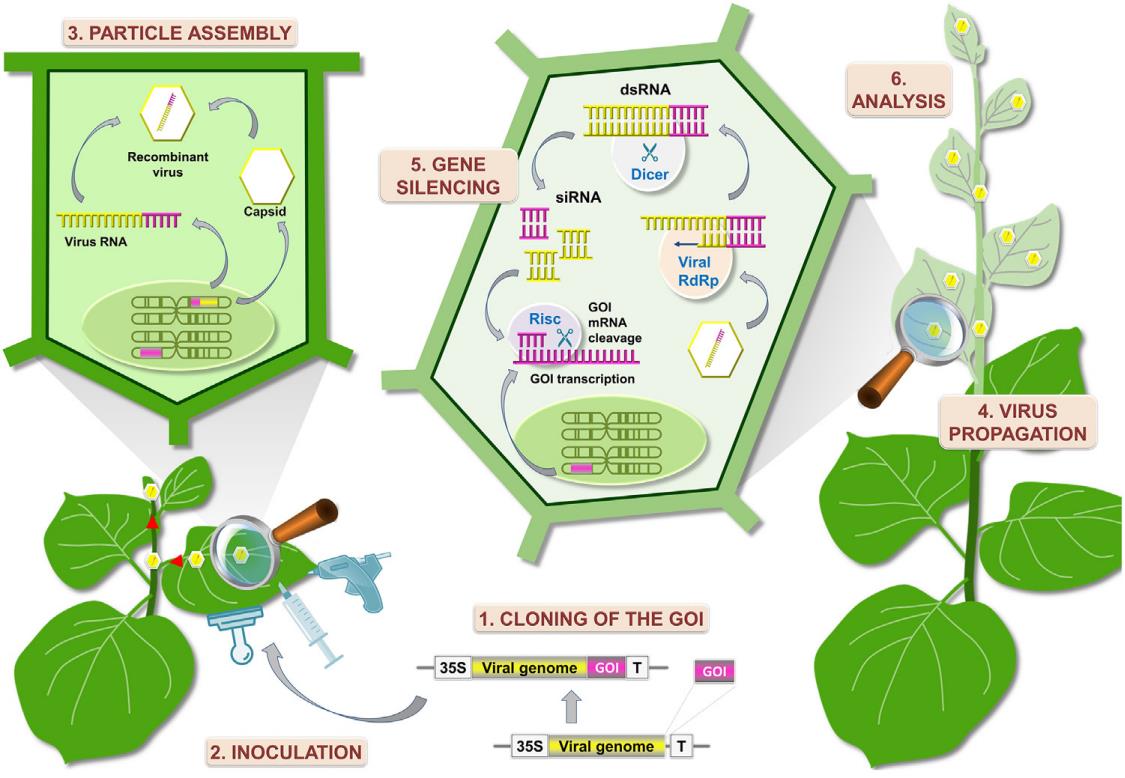Lifeasible offers the state-of-the-art platform for gene-specific silencing in plants by introducing virus-induced gene silencing (VIGS).
VIGS is one of the most powerful reverse genetics tools for rapid determination of plant gene functions and has been now used for diverse monocot and dicot plant species.
VIGS system uses viral vectors carrying a target gene fragment to produce dsRNA which initiate RNA-mediated gene silencing. Briefly, 21-25 nt small interfering RNAs (siRNAs) are produced with the help of RNA-dependent RNA polymerase (RDRP) and Dicer after viral vectors being imported into host cells, followed by their incorporation into RNA-induced silencing complex (RISC). The antisense strand of the siRNA guides degradation or translation suppression of target mRNA at the post-transcriptional level or induces transcriptional inhibition of target mRNA by RNA-directed DNA methylation (RdDM) on the promoter.
VIGS is increasingly used as an alternative to stable transformation-based RNA interference (RNAi) to silence the target genes in plants.
 Figure 1. Virus-induced gene silencing (VIGS). (Courdavault, et al., 2020)
Figure 1. Virus-induced gene silencing (VIGS). (Courdavault, et al., 2020)
The target gene sequence information is provided by the customer, and our experts can also help customers determine the target gene sequence and select the insertion fragment based on the customer's research situation. Whether you want to silence a specific gene or multiple genes, our experts can provide professional and reliable advice.
The construction of viral vectors is particularly important. We can select appropriate viruses to construct VIGS vectors based on plant types and research conditions. Lifeasible has developed a variety of virus-derived vectors and plant transformation systems of tobacco, potato, petunia, cotton, pepper, barley, Arabidopsis, soybean, rice, which are readily available to accommodate the diverse needs of the clients.
Viruses Used to Construct VIGS Vectors
| RNA Viruses | DNA Viruses |
| Tobacco mosaic virus (TMV) Potato virus X (PVX) Tobacco rattle virus (TRV) Brome mosaic virus (BMV) Barley stripe mosaic virus (BSMV) Cucumber mosaic virus (CMV) |
Tomato golden mosaic virus (TGMV) African cassava mosaic virus (ACMV) Cabbage leaf curl virus (CbLCV) |
There are many delivery methods for VIGS, such as friction inoculation, leaf injection, vacuum infiltration, Agrobacterium-mediated agroinfiltration, and biolistic bombardment. The delivery method will affect the efficiency of gene silencing to some extent. Different inoculation sites and different periods of gene silencing require different delivery methods. We will choose the appropriate inoculation method based on the host and viral vector.
We will determine the appropriate cultivation conditions based on the plant and vector.
We provide a variety of analytical services to identify gene silencing effects, including target gene phenotype analysis, silencing efficiency assessment, biochemical analysis, gene function analysis, metabolite profiling, etc.

For more information or to discuss in detail, please contact us.
01
One-stop solution saves time
02
Diverse vectors and transformation systems
03
Professional and experienced team
04
Competitive price in the market
Reference
Lifeasible has established a one-stop service platform for plants. In addition to obtaining customized solutions for plant genetic engineering, customers can also conduct follow-up analysis and research on plants through our analysis platform. The analytical services we provide include but are not limited to the following:
STU-CRISPR System Improves Plant Genome Editing Efficiency
April 19, 2024
Application of Exosomes in Facial Beauty
April 12, 2024